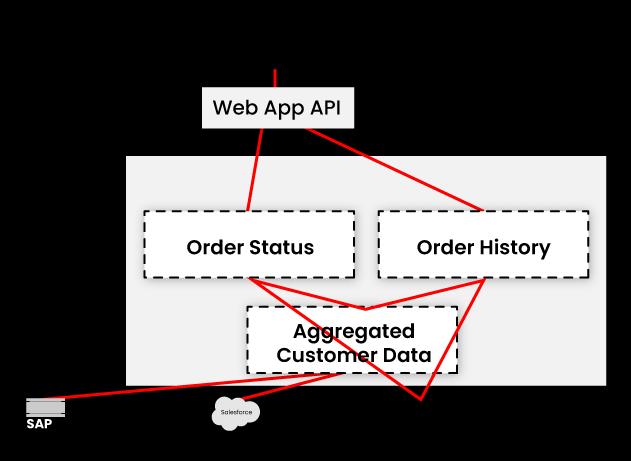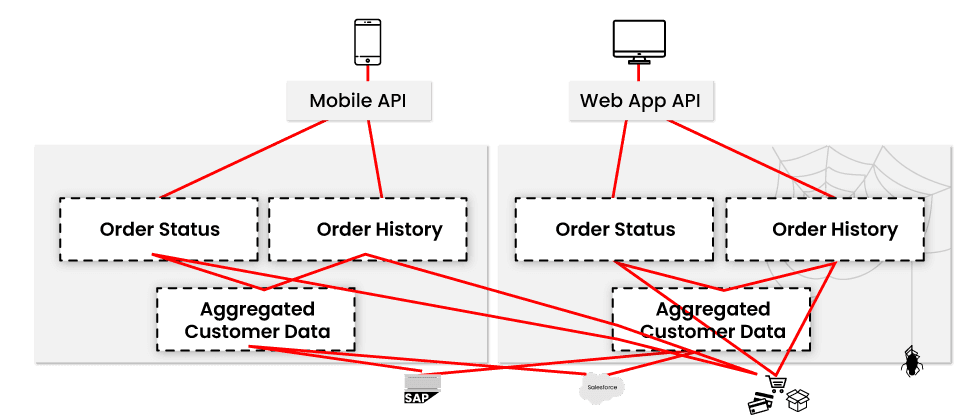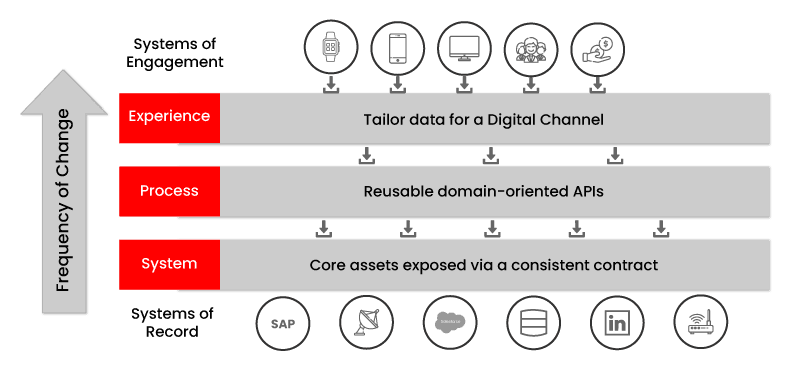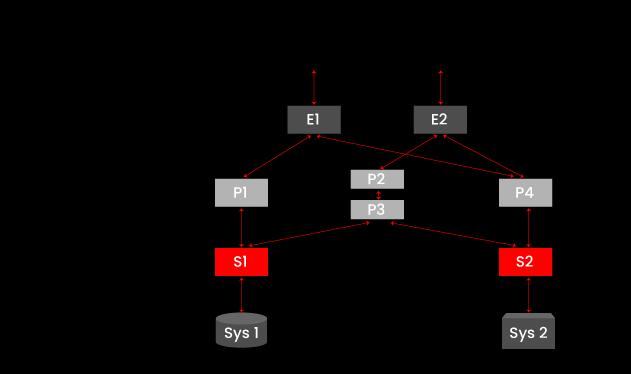- Dell Boomi vs MuleSoft
- Mulesoft Interview Question And Answers
- Introduction to the MuleSoft Anypoint
- Mulesoft Tutorial
- Mulesoft vs Zapier - Key Difference
- Mulesoft vs WebMethods - Key Difference
- Mulesoft vs Alteryx - Key Difference
- What is Mulesoft
- Mulesoft vs Informatica - What's The Difference?
- Mulesoft Architecture
- MuleSoft vs TIBCO - The Key Differences
- Mulesoft Connectors
- What is MuleSoft Developer?
- How to Install Anypoint Studio on Windows
- Mulesoft Integration with Salesforce
Why do we require API-Led Connectivity?
How does API-Led Connectivity Minimise IT’s Workload?
What are the APIs that support API-Led Connectivity?
How API-Led Connectivity work in your business
Advantages of API-Led Connectivity
DataGraph in the Perspective of the API-Lec Connectivity
Differences between iPaaS and low-code/no-code
What do Integration and AI have Mutually?
Mulesoft API-Led Connectivity Architectural and Design Patterns
In Mulesoft, API-Led connectivity is a systematic method to connect the data to the applications using purposeful and reusable APIs. By using this advanced API-Led methodology, every integration turns into a reusable building block. The reusable process allows us to accelerate IT delivery and raise organisational agility.
The Forrester Total Economic Impact Study reveals that Mulesoft customers reclaimed $5.45 for every $1 invested on Mulesoft. Tech Giants like Mastercard, Siemens, Unilever, AT&T, Spotify use Mulesoft to design a network of data and applications. Thus, a skilled and certified Mulesoft developer will have a promising career. If you want to learn Mulesoft, Join our Mulesoft training. This API-Led Connectivity blog discusses what is API-Led connectivity and how it accelerates IT delivery.
Mulesoft API Led Connectivity - Table Of Content
- What is API-Led Connectivity?
- Why do we require API-Led Connectivity?
- How does API-Led Connectivity Minimise IT’s Workload?
- What are the APIs that support API-Led Connectivity?
- How API-Led Connectivity work in your business
- Advantages of API-Led Connectivity
- DataGraph in the Perspective of the API-Lec Connectivity
- Differences between iPaaS and low-code/no-code
- What do Integration and AI have Mutually?
- Mulesoft API-Led Connectivity Architectural and Design Patterns
What is API Led Connectivity?
API Led Connectivity is a technical approach for connecting the data to the applications using purposeful and reusable APIs. We design those APIs to perform a particular role - unlatching data from the systems, transforming data into a process, or offering an experience. When the complete enterprise follows API Led Connectivity, all in business is authorised to access the best abilities in providing projects and applications using self-service, reuse, and discovery.
| Do you want to get certified and build your career in Mulesoft? Then enroll in "Mulesoft Online Training" this course will help you to achieve excellence in this domain. |
Why Do We Require API Led Connectivity?
API Led Connectivity is an essential integration strategy since the technologies that companies are using engross with their employees, partners, and customers have been modified significantly. The conjunction of the company technologies like SaaS, Big data, IoT, mobile, APIs, and social are offering robust new tools to enable enterprises to do more, unlatch the latest revenue streams, comprehend their users better, and introduce rapid than ever before. Yet to do that, we have to integrate these technologies with APIs.

Conventionally, we perform these integrations through point-to-point connections, performed in an ad hoc manner every time a project needs. This results in brittle and difficult systems that tend to fail and need a large amount of IT’s time and assets to maintain.
How Does API-led Connectivity Minimise IT’s Workload?
API-led connectivity has a prominent role to perform. This is due to IT being regularly tasked with deploying these technologies, doing the required changes and preserving inheritance systems. Requests they must satisfy is ever-increasing, precisely as their resources remain persistent. Consequently, we will get the following results:

The number of new projects required to execute today’s technology requirements - calculated against IT’s ability for delivering them - is coiling ever upward. Since the technology needs of the enterprise continuously increase in a multiplicative manner, IT resources will only rise linearly, regardless of how many resources an enterprise can shoot at the problem.
What are the APIs that Support API-led Connectivity?
API-led connectivity offers a technique to connect and expose threats. Through this approach, instead of linking things point-to-point, all the assets become managed API - an advanced API that makes it ascertainable using self-service without depriving control. We use the APIs in the API-led approach to linkage settle into three categories:
- System APIs: Generally, these APIs access core systems of the record and offer ways of insulating users from difficulty or modifications to the inherent systems. After building, various users can access the data without learning the inherent systems and reuse the APIs in different projects.
- Experience APIs: Experience APIs are how we reconfigure the data such that its target audience utilises it, all from the general data source, instead of establishing individual point-to-point integration for every channel. Generally, the Experience API is created with the API-first design principles where we design the API for a particular user experience in mind.
- Process APIs: The Process APIs communicate with and form the data in a single system or throughput systems and are developed here without a dependency on source systems from which data generates and intent channel across which we deliver the data.
By designing and arranging our APIs in this manner, and later making them available and discoverable for the business to the self-service, API-led connectivity has done our business assemblable, enabling teams across the business to adapt, compose, and recompose the APIs for handling the modification requirements of the business.
How API-Led Connectivity Work in your Business?
API-led connectivity is an essential element to close the IT delivery gap. In the conventional point-to-point integration approach, one may want to design the web app for providing the real-world order status and the order history for the sales team to occupy with the customers. For this instance, if we have customer data in Salesforce and SAP; inventory data in SAP; and the Order data in the e-commerce system.
At this s.tage, the IT team may aggregate the customer data by wiring jointly customer data from both systems with code. Later, the aggregated user data is combined with the order data in the e-commerce system for producing order history data and order status. We consider the project a success if we start it on time and budget and it has the proper functionality.
Yet later sales team, who often travel, will demand this functionality must be accessible on their mobile devices. Thus, the task of the IT team is to build a mobile app. Yet, developers developing the application cannot utilise the work done for the previous projects. Therefore, they must repeat the work, which is not a sound output. Although developers know that this is a short-sighted methodology, they condone it provided intense time pressures.

Eventually, modifications become extremely valuable or impracticable to make. Yet as the modification is persistent, agility is now difficult. Through the API-led connectivity technique, when the teams build the latest mobile application, there are reusable assets for creating the form generated from the system and processing the APIs, eradicating all the work required to develop them.
[Also, Know the Differences between Dell Boomi and MuleSoft]
Building the app is a matter of plugging with various systems. It is easy to add and innovate new services. In this instance, insert shipment status information - in the same way, order history and order status was accessed. This preserves resources, money, projects, and time and ensures that we can rapidly complete the tasks.

API-Led connectivity utilises some principles of Service Oriented Architecture(SOA), yet this methodology is the evolution from SOA in the self-service utilisation of the reusable assets. API-Led Connectivity methodology enables developers to compose and recompose the reusable services for building the projects they consider, instead of top-down heavyweight dictates of conventional SOA approaches.
Advantages of API-Led Connectivity
The API-Led Connectivity methodology to provide IT projects assure you are not only on the budget and time with our first projects, yet we have developed reusable assets that will preserve your enterprise money and time, generate the infrastructure that is set for modification, grow in visibility, governance, and most essentially, satisfy the requirements of the business, which is long-term sustained guilty.
[Are You Preparing For MuleSoft Interview Then Checkout: Mulesoft Interview Question & Answers]
It allows us to shift fast on our first project, yet later actually expedite from our project onwards, because of reusable assets and a constructed organisational ability. The API-Led Connectivity releases resources, enabling you to invent and shift rapidly. The users of Mulesoft discovered that rise in agility and hasten offered by API-Led connectivity results in delivering the projects 3x quicker and raised team efficiency by 300%, in comparison to homegrown or legacy integration solutions.
DataGraph in the Perspective of the API-Led Connectivity
GraphQL is a freeware data manipulation and query language for the APIs. It was designed on Facebook and released in 2015. Contrary to SOAP and REST APIs, GraphQL enables all the consumers to define what data it requires and how. It innovates improved query capabilities in a generalised way. The query capabilities comprise sorting, filtering, pagination, join and search operations.
Elasticity utilisation is improved since application developers fetch more freedom and control for defining what they require. So, only the data we require is shifted on the network and utilising applications does not require sorting, joining, or filtering the data.

Anypoint GraphQL urges accessibility of APIs by offering the capability to adapt the data for the requirements of the digital channel. For instance, a mobile application requires only a few fields from the product data set, whereas the web portal requires more data for delivering a comprehensive view. Through Anypoint DataGraph, utilising applications can define their requirements in API calls to DataGraph Endpoint. In Mulesoft, API-Led Connectivity handles similar challenges through the architectural approach; the discovery of the architectural layers with a single dedicated layer catching the details of the digital channels.
Differences between iPaaS and low-code/no-code
Low-code/No-code
Low-code or No-code solutions handle a particular requirement. They enable citizen developers to drag and drop icons that depict applications onto the canvas; later, the “click-and-configure” paradigm connects the icons to corresponding applications.
iPaaS and low-code/no-code
Mulesoft specifies the iPaaS as the platform to build and deploy the integrations in the cloud and between enterprise and cloud. Integrating this specification with digital transformation, an iPaaS enables us to use multiple systems irrespective of the location, retrieving their data, and integrate it in the approaches that allow creation or modification of the latest and available processes.
What do integration and AI have mutually?
In 2018, Gartner forecasted that by 2022, 85% of the AI projects could deliver incorrect outcomes. The subsequent year, Forbes predicted that 87% of the AI Implementations throughout all the industries could fail to attain production, remaining permanently locked elsewhere in the symbolic basement of business. These predictions are the only concern, yet when fixed next to a broader rate of the IT project failure, they turn sorer. PMI research reveals that 14% of IT projects collapse. Why is the delinquency rate of the AI projects is much too high?, and why is it unique from the broader IT Landscape? What makes failure at such catastrophic levels?
Mulesoft API Led Connectivity Architectural and Design Patterns
API Led Connectivity is the architectural style that links data to the application using purposeful and reusable API. API Led Connectivity contains three layers defined, but all the time, it is not required.
1. System API
It allows us to retrieve the primary data from the record system like SAP, JDBC, AS400, Salesforce, etc. We can expose the data retrieval from the backend systems to the upstream API reliably and securely.
- System API is accountable for linking the backend systems and retrieving the necessary raw data.
- Converting the raw data from the backend systems.
- Cleansing preliminary data from the backend systems.
- Error Mapping and Handling from backend systems.
- Revealing the data to upstream API(Experience or Process API) securely and reliably.
2. Process API
It is accountable for understanding the downstream API. The essential functionality of the Process API is to deploy business logic, data aggregation, and data routing. We must address the following questions to design the proper APIs:
- What is the essential functionality of process API?
- Do we need Process API?
- Does Business Logic Available in the backend service?
- Who will use the Process API?
3. Experience API
It is a user-facing API, and we can reuse it through different channels like web applications, mobile applications, or any other way. Usually, Experience APIs are channel-specific.
Use-case 1:
Following are the client requirements for implementing proper API Led Connectivity pattern:
- We have to link and retrieve the data from several core backend systems. Unlatching data from backend systems.
- There is a requirement to gather the data from various systems, aggregate data, and transmit it to clients.
- There may be multiple users of APIs comprising mobile applications, web applications, and other explicit users.
- At every layer, we must secure API.
- The client is waiting to reveal more APIs on top of essential systems. The solution should promote reusability and be futuristic.
Solution
As per the needs, we will use a three-layer API Led Connectivity architecture. System Layer unlocks the system of the records, and Process API collects and aggregates the data from various systems through System API and transmit responses back to Experience API.

The experience API will reveal API to the web applications and mobile applications. Henceforth, we can insert more channel-specific APIs is at the experience layer and reuse system and process APIs.
Use Case 2:
We have collected a requirements list from the client for implementing a proper API Led connectivity pattern.
- Clients have APIs that are already available that link to systems yet written in non- Mulesoft.
- There is a requirement to gather the data from different systems, aggregate it, and transmit it to the clients.
- We can have multiple users of APIs comprising mobile applications, web applications and other explicit users.
- We must Secure the APIs at every layer.
- The client is waiting to reveal more APIs on top of the essential systems. The solution should promote reusability and be futuristic.
- Backend systems are complex and legacy.
Solution
This solution creates the Mulesoft system API wrapper on top of the Non-Mulesoft API. Since the Non-Mulesoft API is heritable and not as per the best practices and Generalized. Through Mulesoft System API, we can use different security policies and allow analytics.
We have various ways where we directly create Mulesoft System API on top of the backend systems, yet those are very difficult and heritage. We can need further efforts for doing that like full development, testing, design, etc.
Conclusion
The API-Led Connectivity is an advanced API-Led approach used in Mulesoft for linking data and applications. Different APIs like System APIs, Experience APIs, and Process APIs will support this approach help us to speed up the IT delivery. I hope this API-Led Connectivity blog provides you with the required information about the API-Led Connectivity methodology.
 On-Job Support Service
On-Job Support Service
Online Work Support for your on-job roles.

Our work-support plans provide precise options as per your project tasks. Whether you are a newbie or an experienced professional seeking assistance in completing project tasks, we are here with the following plans to meet your custom needs:
- Pay Per Hour
- Pay Per Week
- Monthly
| Name | Dates | |
|---|---|---|
| MuleSoft Training | Jan 06 to Jan 21 | View Details |
| MuleSoft Training | Jan 10 to Jan 25 | View Details |
| MuleSoft Training | Jan 13 to Jan 28 | View Details |
| MuleSoft Training | Jan 17 to Feb 01 | View Details |

Viswanath is a passionate content writer of Mindmajix. He has expertise in Trending Domains like Data Science, Artificial Intelligence, Machine Learning, Blockchain, etc. His articles help the learners to get insights about the Domain. You can reach him on Linkedin
















